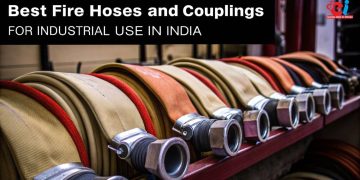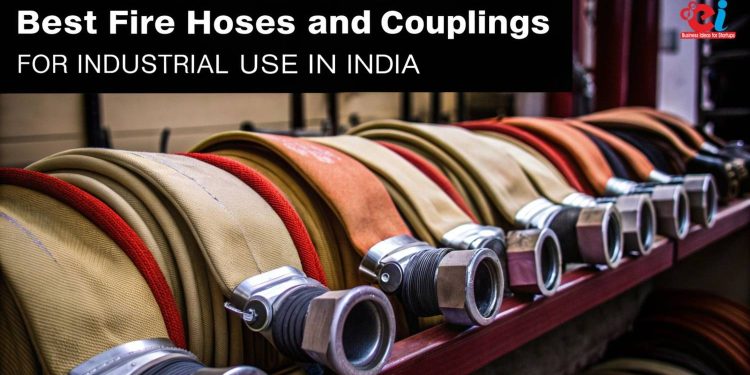Both municipal and industrial infrastructure consider fire safety of equal importance. Having appropriate firefighting equipment affects fire control and the extent of losses incurred. Fire hoses and couplings, and other tools form the basis of the firefighting systems and provide the means through which water or fire-retardant agents are sent into the core of the fire. Handled the wrong way, hoses of different types, materials, sizes, and connection mechanisms would create a challenge for safety officers, facility managers, and local government needing to customize solutions.
Specialization of industries, coupled with urban sprawl has increased the requirement for advanced fire suppression systems. Beyond pressure handling, ease of maneuverability, durability under harsh conditions, legal compliance, and compatibility with hydrant systems adds further complexity to the selection of the correct fire hoses and couplings. This article discusses types of fire hoses and coupling systems with their appropriate use, materials comprising the parts, and the appropriate configuration for a chemical plant, warehouse, airport, or city fire department.
Trust Coupling, The Critical Component to the Fire Hose, for the Flame Extinguishing Gear
Flexibility allows Hoses and Couplings to transport water at a greater pressure and rate than a hydrant, fire truck or pump to its nozzle. Foam can equally be used to put out the fire. Abrasions, extremes of heat, UV light, chemical contact and other factors require fire hoses to be strong and resilient. Couplings are equally as necessary as they simultaneously link several hoses, pumps, nozzles, and hydrants. Incompatible couplings can result in leakage, collapse of flow pressure or disassociation during operations incurring significant losses.
The industrial zone is customized with tools and equipment safer and more appropriate for doing work with leguminous and other flammable chemicals. A certain reliability on fire webcam is needed in order to be useful. The couplings and flames have some ideal characteristics like being possessing loosingigned and light where they are usable around enemy lines alongside being seamless with the plumbing system around the urban battleground. Thus, the fire risks, operational conditions and environment assist in the custom fitting of the correct Hoses and Couplings.
Marking Fire Hoses and Couplings by Their Intended Use and Configuration
Every type of fire hose has its own unique purpose in firefighting and comes in different varieties. The common ones are attack hoses, supply hoses, suction hoses, booster hoses, and forestry hoses.
Firefighters use attack hoses to directly apply foam or water onto the flames. These hoses are very flexible, able to withstand very high pressures, and usually have a rubber or polyurethane lining to reduce the chances of abrasions. They typically have a diameter of 1.5 to 3 inches and are placed into position manually by the firefighters.
As for supply Hoses and Couplings, they are meant to transfer water from a hydrant or tanker to the fire truck or engine. These hoses have a bigger diameter—usually 4 to 6 inches. Moreover, they are able to move large volumes of water over relatively longer distances. While lacking flexibility, these hoses do need to be extremely durable and resistant to kinking.
In order to ensure water is drawn into the pump, it is necessary to use suction hoses that access open water sources such as ponds and reservoirs. These hoses are stiff and are usually reinforced with metal rings that keep them from collapsing due to the suction pressure. These types of hoses are particularly important in rural settings where there may be no access to municipal fire hydrants.
Booster hoses are used for initial response units and for small fires. They are equipped with rubber coating and have a smaller diameter. These are mounted on reels and are part of many fire engines. They are easier to work with as they can be lighter.
Forest hoses are suitable for scenarios that involve forest fires or wildland fires as they are tested to be lightweight, flexible, and able to withstand abrasion, heat, and tree vegetation snags all the while maintaining optimal flow.
Material Considerations in Fire Hoses
Flexibility and durability are essential components of fire Hoses and Couplings and while the materials used in it, this largely depend on the injuries extreme conditions fire hoses endure depending. The effectiveness, lifespan, and safety of a fire hose is highly dependent on the material used. The inner lining of modern fire Hoses and Couplings usually use synthetic rubber or thermoplastic for water tightness which gives resistance to mold and mildew. The outer jacket is mostly composed of nylon or polyester which sits tightly to defend cuts and UV degradation.
The single jacket hoses are used in lighter applications or in the interior fire suppression systems, while the double jacketed hoses are used in municipal firefighting due to the added durability. Some hoses are also enhanced by applying coatings that protect from chemicals, oils, and very high or low temperatures.
In industrial applications, these hoses made out of rubber may have linings made resistant to chemicals or outer coatings applied for protective purposes in areas such as refineries, chemical plants, or other manufacturing units where the hose may come in contact with dangerous materials. The choice of the material to make the hose must, therefore, consider not only the needs for pressure and volume but also the prevailing environmental and chemical conditions in the area of application.
Fire Hose Couplings: The Unrivaled Link
These fittings are called fire hose couplings and work in silence in the firefighting systems. These type of connectors guarantee the dependable and tight connection between two parts of hose and between hoses and pumps, nozzles, and hydrants. Their construction should permit quick joining and separating while withstanding considerable flow pressure for the hose interior.
Different types of coupling mechanisms are used around the globe. The Instantaneous coupling or the British Fire Service coupling (John Morris coupling) is the most popular in India and some commonwealth countries. It has a spring-loaded mechanism for quick push-in connection and twist-to-release features. This type is frequently employed by municipal fire departments.
Storz couplings are prominent in other areas, especially in the European region. These are symmetrical couplings and enable connections without distinguishing between male and female ends. Their locking system provides a secure seal, and because of the design, it allows quick connection and disconnection, even in poor visibility or while gloved.
In American fire systems, threaded couplings with male and female threads are prevalent. These provide a good connection, but they are slower to attach, and increasingly being phased out for quicker emergency options.
In industrial fire fighting systems, camlock couplings are commonly used. Their simplicity of use with chemical and foam extinguishing systems makes these ideal for complex industrial environments.
Depending on requirements for pressure, weight, and resistance to corrosion, couplings are typically made from brass, aluminum, or gunmetal. In more corrosive industrial settings, couplings with chemical resistant coatings or made from stainless steel are preferable.
Selecting the Best Fire Hoses and Coupling System
Each fire hose and coupling system has a different use case. For flexibility and ease of use, the construction must be lightweight, and standard hydrants need to be compatible. British instantaneous couplings are suitable to use for attack hoses with urban firefighting teams. The hose also has to be optimized in length for city use – too short, and it limits reach; too long, and it becomes difficult to maneuver.
In industrial use, there is a shift in focus to a more durable construction that features chemical resistance as well as higher pressure ratings. Hose construction needs to hold not only hydraulic forces due to water, but also exposure to solvents, oils, and thermal shock. These facilities may require suction hoses if they are located near open reservoirs or tanks. Such scenarios usually favor the use of camlock or flanged couplings due to their strength and compatibility with fixed systems.
Lightweight for forestry hoses makes them ideal for firefighting in wooded or rural areas. They are used alongside portable pumps and have to be long enough to cross difficult terrain.
Moreover, fire services and other safety operators need to account for maintenance and replacement schedules. Purchases, such as a hose or coupling that performs well but must be replaced often, may still turn out to be cost prohibitive in the long run. The equipment is guaranteed to be of national and international standards, so choosing BIS NFPA, or ISO certified products guarantees that appropriate measures of performance, endurance, and safety are met.
Conclusion: Smart Fire Safety Starts with the Right Equipment
The effectiveness of a fire response strategy lies in its details, and choosing the right fire hoses and coupling is one such detail that can have life-saving implications. Whether you’re outfitting a city’s fire brigade, a chemical factory’s emergency unit, or a rural firefighting team, understanding the different types of hoses and coupling mechanisms empowers you to make informed, cost-efficient, and safety-conscious decisions.
As fire risks evolve with industrial complexity and urban expansion, the tools we use must evolve as well. Prioritizing durability, ease of use, compatibility, and regulatory compliance in your firefighting infrastructure will not only ensure rapid response during emergencies but also build long-term resilience into your safety systems.
Our team at Niir Project Consultancy Services (NPCS) can provide you with a complete market analysis, project report, product sourcing strategy, and setup support for manufacturing fire safety equipment.


























